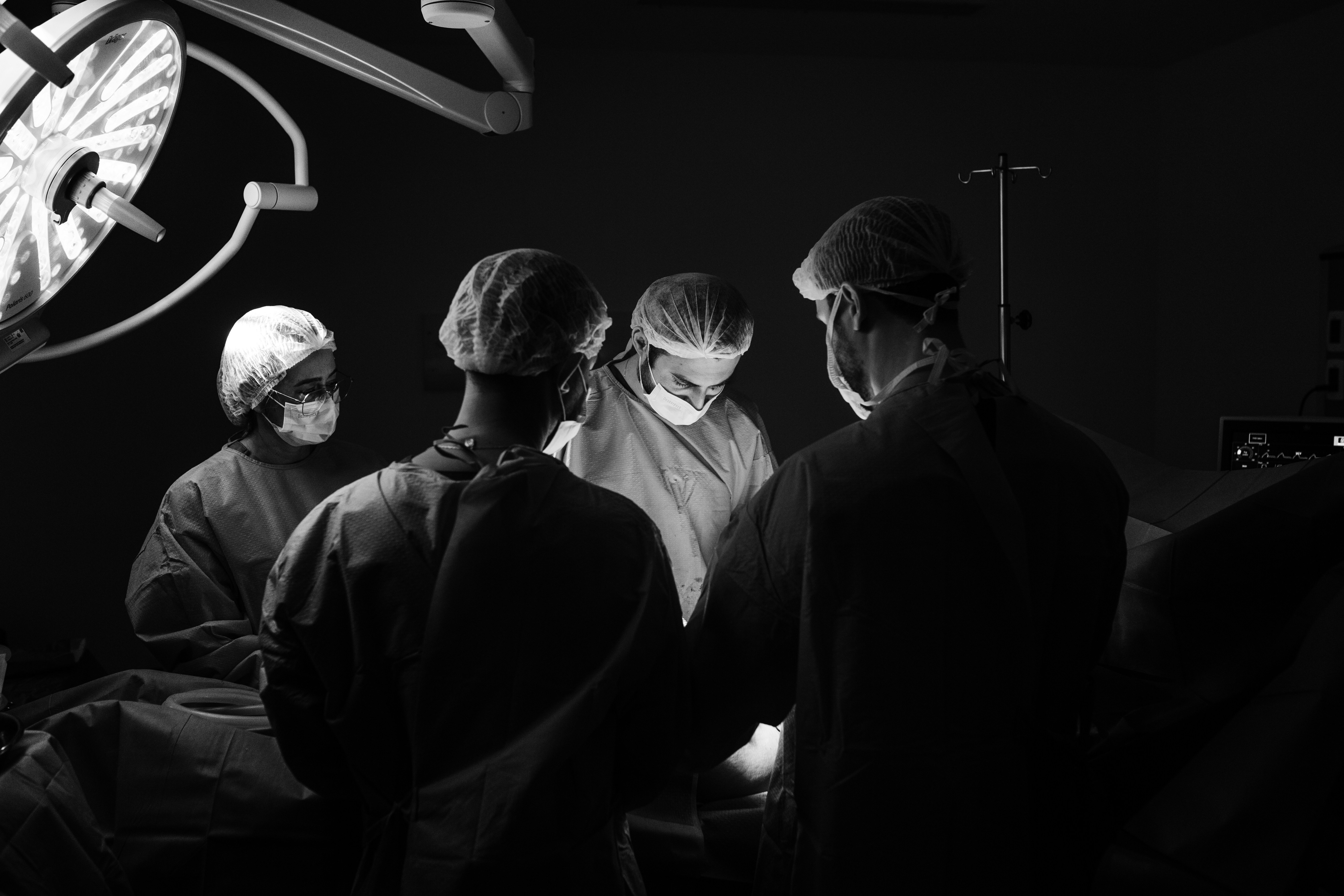11 มี.ค. 2568

In the ever-evolving landscape of healthcare, few technological advancements have captured the imagination and potential quite like augmented reality (AR) in surgery.
Gone are the days when surgeons relied solely on their naked eye and steady hand. Today, AR is opening up new vistas of precision, allowing us to see beyond the surface and navigate the intricacies of the human body with unprecedented accuracy. But what exactly does this mean for patients on the operating table, and how is it changing the game for those of us wielding the scalpel? Let's scrub in and explore.
Current Challenges in Traditional Surgical Methods
Limitations of Human Vision and Dexterity
As skilled as we surgeons may be, we're still human, with all the limitations that entails. Our eyes, remarkable as they are, can only see so much. When dealing with the microscopic structures of the brain or the labyrinthine pathways of the vascular system, even the keenest vision can fall short. And let's not forget about those hard-to-reach nooks and crannies of the body that can turn a straightforward procedure into an exercise in contortionism!
We can all recall particularly challenging surgeries where accessing the affected area without disturbing the surrounding structures felt like threading a needle in the dark. It's moments like these when we wish for x-ray vision or, better yet, a way to see a roadmap of the patient's anatomy superimposed right before our eyes.
Risk of Errors and Complications
With limited visibility comes an increased risk of errors. A millimeter off here, a slight tremor there, and suddenly we're in dangerous territory. Complications such as unintended tissue damage, excessive bleeding, or misplaced implants can turn a routine operation into a high-stakes scenario. It's a heavy burden, knowing that the slightest misstep could have profound consequences for the patient lying before us.
The margins for error are often razor-thin, and the consequences of crossing them can be devastating. A nick to the spinal cord during vertebral fusion, an inadvertent cut to the bile duct in laparoscopic cholecystectomy, or damage to facial nerves during parotidectomy—these are the nightmares that haunt every surgeon's dreams.
Impact on Patient Outcomes
The repercussions of these challenges ripple out to affect patient outcomes. Longer recovery times, increased pain, and the potential need for revision surgeries are just some of the ways patients can suffer when precision is compromised. As healthcare providers, our primary goal is to heal, not harm. Yet, the inherent difficulties of complex surgeries can sometimes work against us, leading to suboptimal results despite our best efforts.
Moreover, the psychological impact on patients shouldn't be underestimated. The anxiety of facing a "redo" surgery, the frustration of a prolonged recovery, or the disappointment of persistent symptoms can take a toll on mental health and erode trust in the healthcare system. And let's not forget the wider societal costs: lost productivity, strain on families, and the economic burden of additional treatments and rehabilitation.
How Augmented Reality Can Enhance Surgical Precision
Real-time Visualization of Patient Anatomy
Now, imagine a world where the patient's CT scan or MRI isn't just a reference image on a screen across the room, but a three-dimensional hologram floating right above the surgical site. That's the magic of AR in surgery. By overlaying digital images onto the real world, AR provides surgeons with an x-ray vision of sorts, allowing us to peer through skin, muscle, and bone to visualize critical structures in real-time.
Picture yourself performing a partial nephrectomy for renal cancer. Traditionally, you'd rely on preoperative imaging and intraoperative ultrasound to locate the tumor and determine your resection margins. But with AR, a 3D model of the kidney materializes before your eyes, with the tumor glowing red, and renal arteries and veins clearly delineated in different colors. As you manipulate the tissue, the model moves in sync, constantly updating your spatial awareness. You can see exactly where to clamp, where to cut, and most importantly, what to avoid.
Guidance for Precise Incisions and Movements
With AR, gone are the days of relying solely on anatomical landmarks or 'eyeballing' them. The technology can project guidelines directly onto the patient, showing us exactly where to make that first incision or how deep to place a screw. It's like having a master surgeon looking over our shoulder, guiding our every move.
In orthopedic surgeries, where alignment is everything, AR has been a game-changer. Whether it's ensuring a hip implant is positioned at just the right angle or aligning a knee replacement to restore natural gait, the precision afforded by AR can make the difference between a good outcome and a great one.
Envision a pedicle screw placement in spinal fusion surgery. Instead of repeatedly checking fluoroscopic images and mentally translating them to the patient's anatomy, AR superimposes a corridor onto each vertebra, showing the optimal trajectory for each screw. As the surgeon advances the drill, real-time feedback indicates any deviation from the planned path. It's akin to a pilot's heads-up display, providing critical information without the need to look away from the task at hand.
Improved Accuracy and Efficiency in Complex Procedures
Complex procedures that once took hours can now be streamlined with the help of AR. By providing a clear visual of the surgical target and the safest route to reach it, AR helps minimize unnecessary exploration and reduce operative time. This not only benefits the patient by decreasing time under anesthesia but also allows surgeons to work more efficiently without compromising on quality.
But the benefits of AR-enhanced efficiency go beyond just saving minutes in the OR. Take the case of arteriovenous malformation (AVM) resection in the brain. These tangled knots of abnormal blood vessels are like vascular minefields, where one wrong snip can trigger catastrophic bleeding. AR can map out the feeding arteries, draining veins, and the nidus itself, transforming a painstaking, high-risk dissection into a more straightforward task of following a well-marked path. The result? Shorter anesthesia time, less brain retraction, and ultimately, better outcomes for our patients.
The beauty of AR in all these scenarios is that it doesn't replace surgical skill—it augments it. It takes the expertise we've honed over years of training and practice and elevates it to new heights. With AR as our ally, we can push the boundaries of what's operable, tackle cases that once seemed impossible, and most importantly, give our patients the best possible chance at a full recovery.
Advantages of Using Augmented Reality in Surgery
Reduced Risk of Complications
By providing enhanced visualization and precision guidance, AR acts as a safety net, helping surgeons navigate around pitfalls that could lead to complications. Whether it's avoiding a critical blood vessel during tumor removal or ensuring all fragments are cleared in orthopedic trauma surgery, AR gives us an extra layer of assurance that we're treading carefully.
Consider the delicate dance of acoustic neuroma removal, where the facial nerve often lies draped across the tumor like a thin wire across a landmine. One slip and the patient risks permanent facial paralysis. With AR, we can trace the nerve's path in real-time, even as it's displaced by the tumor. The technology acts like a sixth sense, alerting us to danger before our scalpels come close.
Faster Recovery Times for Patients
When surgeries are performed with greater precision, it often translates to less collateral damage to healthy tissues. Smaller incisions, targeted interventions, and reduced operative time all contribute to faster healing. Patients who might have spent a week in the hospital after traditional open surgery can sometimes go home in a day or two following an AR-assisted procedure.
The ripple effects of faster recovery extend far beyond the hospital walls. It means less time away from work, reduced risk of hospital-acquired infections, and a quicker return to the activities that give life meaning. For our patients, that could be anything from playing with grandchildren to summit a mountain—goals that feel more attainable when recovery is measured in days rather than months.
Increased Success Rates for Procedures
Success in surgery isn't just about getting through the operation—it's about achieving the intended outcome and restoring quality of life. AR is moving the needle on both fronts. From more complete tumor resections in oncological surgery to better-aligned joints in orthopedics, the technology is helping us not just finish procedures, but truly succeed at them.
Even in more common procedures, the impact is profound. Studies on AR-assisted total knee arthroplasty have shown improved postoperative mechanical alignment and balance, key factors in implant longevity, and patient satisfaction. When we hear from patients who can walk pain-free for the first time in years or return to the golf course they thought they'd left behind for good, we're reminded that surgical success is measured not just in technical execution, but in restored possibilities.
Challenges and Limitations of Augmented Reality in Surgical Procedures
Cost and Accessibility of AR Technology
As with any new technology, the elephant in the OR is cost. High-end AR systems can run into hundreds of thousands of dollars, putting them out of reach for many hospitals and clinics, especially in underserved areas. There's also the question of ongoing expenses for software updates, maintenance, and eventually, replacement of hardware.
AR relies on high-resolution imaging, robust computer systems, and often, seamless internet connectivity. In areas where CT scanners are shared between hospitals or broadband is unreliable, implementing AR isn't just a matter of purchasing a device—it's about building an entire ecosystem of technological infrastructure.
Surgical Training Requirements for Surgeons and Medical Professionals
Using AR effectively isn't just a matter of putting on a headset and diving in. There's a learning curve involved in interpreting the augmented display and integrating it into surgical workflow without it becoming a distraction.
The challenges are multifaceted. First, there's the technical aspect—understanding the software, calibrating the system, and troubleshooting glitches. It's essentially learning a new language, one of pixels and prompts. Then there's the perceptual adaptation. AR overlays can sometimes create visual clutter, and learning to focus on the right cues while filtering out unnecessary information is crucial.
Moreover, AR introduces new team dynamics in the OR. Scrub nurses and anesthesiologists need to understand what the surgeon is seeing to anticipate needs and communicate effectively. It's no longer enough to know the steps of a procedure; now, the entire team must be literate in augmented interfaces.
Potential Errors and Malfunctions of Surgeries with Augmented Reality
While AR aims to reduce human error, it introduces the possibility of technological error. In the heat of surgery, even a moment's confusion could have serious consequences. It's crucial that surgeons don't become overly reliant on the technology and maintain the skills to proceed safely if the AR system goes down.
There are also concerns about "automation bias," where users place undue trust in computerized systems. In the context of AR surgery, this could mean following a projected guideline without the usual double- and triple-checks we've been trained to perform.
Data security presents another potential minefield. AR systems often draw upon patient imaging stored in the cloud or transmitted across networks. One breach could expose sensitive medical information, raising privacy concerns and opening healthcare institutions to liability.
Future Possibilities and Advancements in Augmented Reality for Surgical Navigation
Integration with Artificial Intelligence for Enhanced Decision-Making
The next frontier? Marrying AR with artificial intelligence (AI) to create systems that not only show us patient anatomy but actively assist in decision-making. Imagine an AR display that could alert you to anomalies, suggest the safest approach to a lesion, or even predict potential complications based on the patient's unique physiology. It's not science fiction—it's the not-so-distant future of surgery.
Consider tumor resection. Current AR systems can show us the mass and surrounding structures, but what if they could also analyze the tumor's border in real-time, distinguishing between malignant and healthy tissue at a cellular level? We envision AI-powered AR that highlights areas of concern, perhaps even providing a "risk heat map" that guides our dissection to achieve optimal margins while sparing critical structures.
The implications for personalized medicine are staggering. By combining AR's visual guidance with AI's data-crunching power, we could tailor every incision, and every suture to the individual before us. Surgical plans could be dynamically adjusted based on intraoperative findings, with AI algorithms weighing factors too numerous for any human to process at the moment.
Development of Specialized AR Tools for Different Surgical Specialties
As AR in surgery matures, we're likely to see more tailored solutions emerge. Neurosurgeons might have displays that integrate brain mapping data, while cardiac surgeons could benefit from real-time flow dynamics overlays. By fine-tuning AR to the specific needs of each specialty, we can push the boundaries of what's possible in the OR.
For oncologic surgeons, this might mean AR systems that incorporate molecular imaging, showing not just a tumor's location but its metabolic activity or receptor status. Imagine being able to see, in real-time, how cancer cells are responding to treatment, guiding decisions about the extent of resection or the need for intraoperative chemotherapy.
In the world of transplant surgery, AR could revolutionize organ harvesting and implantation. Picture a system that guides the division of vasculature during procurement, ensuring the perfect length of vessels for the recipient's anatomy. During implantation, AR could help position the new organ optimally, perhaps even simulating blood flow to predict the best sites for anastomoses.
Plastic and reconstructive surgeons might soon wield AR tools that project the expected postoperative result onto the patient, adjusting in real-time as flaps are raised or implants positioned. It would be like sculpting with a preview mode, allowing for fine-tuning before the first permanent suture is placed.
Conclusion
As we've explored the landscape of augmented reality in surgery, it's clear that we're standing on the brink of a new era in healthcare. From enhancing our vision beyond human limits to guiding our hands with unprecedented precision, AR is redefining what it means to be a surgeon. But more importantly, it's redefining what it means to be a patient undergoing surgery.
As AR technology continues to evolve, integrating with AI and spawning specialized tools for every corner of surgery, we believe we're looking at nothing short of a revolution in healthcare. A future where precision is the norm, not the exception. Where the anxiety of going under the knife is tempered by confidence in cutting-edge technology. Where surgeons like ourselves can push the boundaries of what's treatable, armed with digital sight and GPS-guided hands.
So here's to the promise of augmented reality in surgery—not just as a stunning technological achievement, but as a beacon of hope for patients and practitioners alike. Because at the end of the day, that's what it's all about bringing a brighter, healthier future into focus, one augmented procedure at a time.
FAQs: Using AR in surgery
Is augmented reality the same as virtual reality in surgery?
No, they're distinct technologies. Virtual reality (VR) immerses the user in a completely digital environment, which can be useful for surgical training and planning. Augmented reality (AR), on the other hand, overlays digital information in the real world, making it more suitable for use during actual surgical procedures.
Does using AR in surgery mean the doctor isn't skilled enough?
Not at all! AR is a tool that enhances a surgeon's skills, much like how a microscope augments vision. Even the most experienced surgeons can benefit from the additional precision and information AR provides, especially in complex cases. Surgical teams and medical students can also benefit from using AR in surgical practices.
Will AR make surgery more expensive for patients?
While the initial investment in AR technology is significant, the long-term benefits—such as shorter hospital stays, lower complication rates, and reduced need for revision surgeries—may actually help control healthcare costs over time.
Can any type of surgery use augmented reality?
AR has applications across many surgical fields, but it's particularly beneficial in areas where precision is critical, such as neurosurgery, orthopedics, and minimally invasive procedures. However, as technology advances, we're seeing creative uses in everything from plastic surgery to cardiac operations.
What happens if the AR system malfunctions during surgery?
Surgeons trained in AR are also fully capable of performing procedures without it. An AR malfunction would be treated like any other equipment issue in the OR—the system would be disengaged, and the surgeon would continue using traditional techniques, prioritizing patient safety above all.





